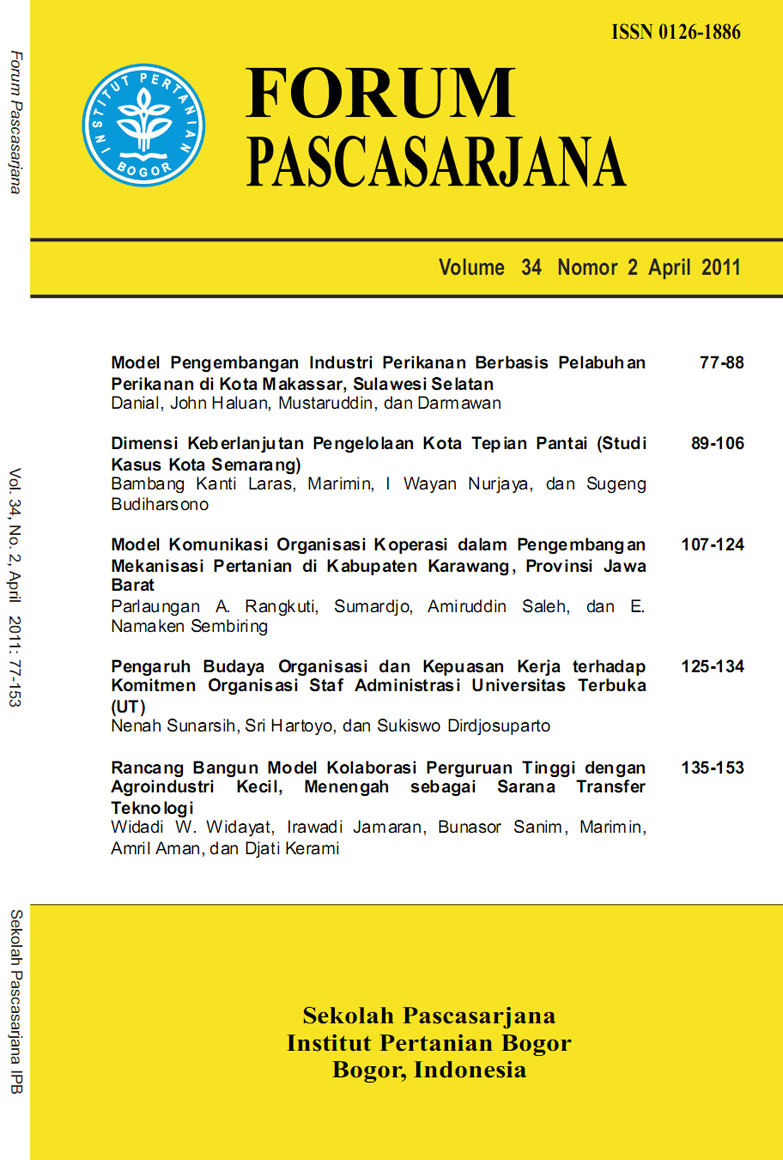<p class="MsoNormal" style="text-align:justify;text-indent:1cm;"><em><span style="font-size:10pt;">Semarang waterfront is a unique ecosystem which has a variety potentialities and problem of using some natural resources, especially in the trade</span></em><em><span style="font-size:10pt;" lang="in" xml:lang="in">-</span></em><em><span style="font-size:10pt;">off between economic growth and ecological preservation.</span></em><em><span style="font-size:10pt;"> <span> </span><span lang="in" xml:lang="in">Generally</span></span></em><em><span style="font-size:10pt;"> the handling operation of waterfront city in Indonesia </span></em><em><span style="font-size:10pt;" lang="in" xml:lang="in">is</span></em><em><span style="font-size:10pt;"> not effective, cause</span></em><em><span style="font-size:10pt;" lang="in" xml:lang="in">d by</span></em><em><span style="font-size:10pt;"> (1) low budged and increase the poverty; (2) over loaded investment; (3) destroyed of ecology and ecosystem; (4) the lost</span></em><em><span style="font-size:10pt;" lang="in" xml:lang="in"> of</span></em><em><span style="font-size:10pt;"> local wisdom; and (5) other problem in commonly urban city. </span></em><em><span style="font-size:10pt;"><span> </span></span></em><em><span style="font-size:10pt;">Based on these condition</span></em><em><span style="font-size:10pt;" lang="in" xml:lang="in">s</span></em><em><span style="font-size:10pt;">, this research aimed to design an environmental management policy ensuring a profitable synergy of all stakeholders without sacrific</span></em><em><span style="font-size:10pt;" lang="in" xml:lang="in">ing</span></em><em><span style="font-size:10pt;"> the principles of environmental conservation.</span></em><em><span style="font-size:10pt;"> <span> </span><span lang="in" xml:lang="in">The objective of this study was to analyze the index and sustainability status of the Semarang waterfront area, based on five sustainable dimensions</span></span></em><em><span style="font-size:10pt;">.</span></em><em><span style="font-size:10pt;"> <span> </span><span lang="in" xml:lang="in">Secondary data resources have been used from literature study and references, primary data have been received from questionairy feedback and expert judgement survey. </span></span></em><em><span style="font-size:10pt;"><span> </span>The</span></em><em><span style="font-size:10pt;" lang="in" xml:lang="in"> analysis</span></em><em><span style="font-size:10pt;" lang="in" xml:lang="in"> </span></em><em><span style="font-size:10pt;"><span> </span>used multi dimensional scalling (MDS) </span></em><em><span style="font-size:10pt;" lang="in" xml:lang="in">method, called Rap-WITEPA,</span></em><em><span style="font-size:10pt;"> and</span></em><em><span style="font-size:10pt;"> <span lang="in" xml:lang="in">the results were stated in the index and sustainability status.The second objective was to analyze the attributes that affect sensitivity on index and sustainability status and the effect of error using Laverage and Monte Carlo Analysis</span></span></em><em><span style="font-size:10pt;">. </span></em><em><span style="font-size:10pt;"><span> </span></span></em><em><span style="font-size:10pt;">The result</span></em><em><span style="font-size:10pt;" lang="in" xml:lang="in"> of</span></em><em><span style="font-size:10pt;"> this </span></em><em><span style="font-size:10pt;" lang="in" xml:lang="in">study show</span></em><em><span style="font-size:10pt;"> that</span></em><em><span style="font-size:10pt;" lang="in" xml:lang="in"> ecological dimension was in the status of less sustainable (49,34), economical dimension was sufficient</span></em><em><span style="font-size:10pt;"> sustainable</span></em><em><span style="font-size:10pt;" lang="in" xml:lang="in"> (53,96), socio-culture dimension was sufficient sustainable (52,21), dimension of infrastructure and technology was sufficient sustainable (56,72) and dimension of law & institutional was the highest sufficient sustainability value index (57,19). <span> </span>Out of 94 attributes analyzed, there were 50 attributes need to be handled immediately as they affect sensitivity on the increase of index and sustainability status with negligible error in the level of 95% confidence limit. <span> </span>It was concluded that an</span></em><em><span style="font-size:10pt;" lang="in" xml:lang="in"> </span></em><em><span style="font-size:10pt;" lang="in" xml:lang="in">i</span></em><em><span style="font-size:10pt;">mportant factor of waterfront city handling operation design in Semarang is social community development, land use efficiency, industry contribution, electricity</span></em><em><span style="font-size:10pt;" lang="in" xml:lang="in">,</span></em><em><span style="font-size:10pt;"> and local society organization.</span></em><em></em></p> <p class="MsoNormal" style="text-align:justify;"><em><span style="font-size:10pt;" lang="in" xml:lang="in"> </span></em></p> <p class="MsoNormal" style="text-align:justify;"><em><span style="font-size:10pt;" lang="in" xml:lang="in">Key words:</span></em><em><span style="font-size:10pt;" lang="in" xml:lang="in"> </span></em><em><span style="font-size:10pt;" lang="in" xml:lang="in">sustainability index, sustainability status, waterfront city</span></em></p>
Abstract
Semarang waterfront is a unique ecosystem which has a variety potentialities and problem of using some natural resources, especially in the trade-off between economic growth and ecological preservation. Generally the handling operation of waterfront city in Indonesia is not effective, caused by (1) low budged and increase the poverty; (2) over loaded investment; (3) destroyed of ecology and ecosystem; (4) the lost of local wisdom; and (5) other problem in commonly urban city. Based on these conditions, this research aimed to design an environmental management policy ensuring a profitable synergy of all stakeholders without sacrificing the principles of environmental conservation. The objective of this study was to analyze the index and sustainability status of the Semarang waterfront area, based on five sustainable dimensions. Secondary data resources have been used from literature study and references, primary data have been received from questionairy feedback and expert judgement survey. The analysis used multi dimensional scalling (MDS) method, called Rap-WITEPA, and the results were stated in the index and sustainability status.The second objective was to analyze the attributes that affect sensitivity on index and sustainability status and the effect of error using Laverage and Monte Carlo Analysis. The result of this study show that ecological dimension was in the status of less sustainable (49,34), economical dimension was sufficient sustainable (53,96), socio-culture dimension was sufficient sustainable (52,21), dimension of infrastructure and technology was sufficient sustainable (56,72) and dimension of law & institutional was the highest sufficient sustainability value index (57,19). Out of 94 attributes analyzed, there were 50 attributes need to be handled immediately as they affect sensitivity on the increase of index and sustainability status with negligible error in the level of 95% confidence limit. It was concluded that an important factor of waterfront city handling operation design in Semarang is social community development, land use efficiency, industry contribution, electricity, and local society organization.
Key words: sustainability index, sustainability status, waterfront city

